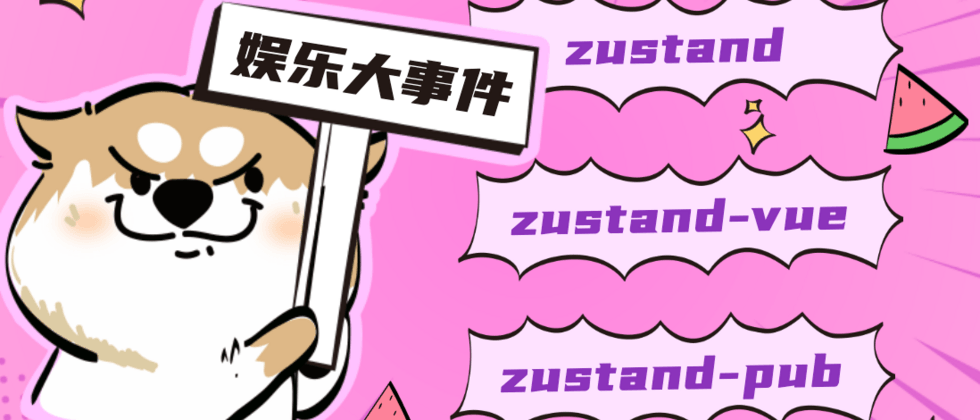如果有兴趣了解更多用法及 api ,点击此处解锁中文文档
前言
是不是觉得 Redux 很难用?想用 Context 代替,但是你知道吗,Context 也有个很大的缺点:
- context value发生变化时,所有用到这个context的组件都会被重新渲染,即使 component 需要的 state 可能根本沒有变动。基于 context 维护的模块越多,影响范围越大, 某些情况下会导致页面明显卡顿。
- 另外,它依赖 Context Provider 包裹你的应用程序。
那么试试 zustand 吧,当然你可以选择 mobx,
zustand 与 mobx 最大的差别在于:
- zustand 的状态更新遵循 react 思想,采用自然不可变更新, 而 mobx 类似 vue,基于数据劫持直接修改状态本身。
体现在开发层面最直观的差异就是:
zustand 状态更新,新状态覆盖旧状态
state = {a: 1} update(){ state = {a: 2} }mobx 状态更新,直接修改属性值
state = {a: 1} update(){ state.a++ }
对比其他状态管理框架
为什么是 zustand 而不是 redux?
- 轻巧灵活
- 将
hooks作为消费状态的主要手段 - 不需要使用
context provider包裹你的应用程序 - 可以做到瞬时更新(不引起组件渲染完成更新过程)
为什么是 zustand 而不是 react Context?
- 不依赖
react上下文,引用更加灵活 - 当状态发生变化时
重新渲染的组件更少 - 集中的、基于操作的状态管理
为什么是 zustand-vue 而不是 pinia?
- 基于不可变状态进行更新,
store 更新操作相对更加可控 - 将
composition api作为消费状态的主要手段,而不是 Vue.use 全局注入
最重要的是
- 基于 zustand-pub 可以为 Iframe、微前端、Module Fedetation、模块化、组件化 等业务场景,提供 跨应用、跨框架 的 状态管理 及 状态共享 能力。
React 上手三部曲
Step 1: 安装
npm install zustand # or yarn add zustandStep 2: Store 初始化
创建的 store 是一个 hook,你可以放任何东西到里面:基础变量,对象、函数,状态必须不可改变地更新,set 函数合并状态以实现状态更新。
import { create } from 'zustand'
const useBearStore = create((set) => ({
bears: 0,
increasePopulation: () => set((state) => ({ bears: state.bears + 1 })),
removeAllBears: () => set({ bears: 0 }),
}))Step 3: Store 绑定组件,就完成了!
可以在任何地方使用钩子,不需要提供 provider。
基于 selector 获取您的目标状态,组件将在状态更改时重新渲染。
选择目标状态:bears
function BearCounter() {
const bears = useBearStore((state) => state.bears)
return <h1>{bears} around here ...</h1>
}更新目标状态:bears
function Controls() {
const increasePopulation = useBearStore((state) => state.increasePopulation)
return <button onClick={increasePopulation}>one up</button>
}Vue 上手三部曲
什么,你还想试试在 Vue 中使用?那么 Step1 与 Step2 基本一致,不同的是 Step3 (Store 绑定组件):
Step 1: 安装
npm install zustand-vue # or yarn add zustand-vueStep 2: Store 初始化
创建的 store 是一个 hook,你可以放任何东西到里面:基础变量,对象、函数,状态必须不可改变地更新,set 函数合并状态以实现状态更新。
import create from "zustand-vue";
const useBearStore = create((set) => ({
bears: 0,
increasePopulation: () => set((state) => ({ bears: state.bears + 1 })),
removeAllBears: () => set({ bears: 0 }),
}))
export default useBearStoreStep 3: Store 绑定组件,就完成了!
基于 selector 获取您的目标状态,组件将在状态更改时重新渲染。
Store 绑定组件在vue3与vue2中有所不同。
<template>
<div>store.bears: {{ bears }}</div>
<button @click="increasePopulation">increasePopulation</button>
<button @click="removeAllBears">removeAllBears</button>
</template>
<script>
import useBearStore from "./store";
const increasePopulation = useBearStore((state) => state.increasePopulation);
const removeAllBears = useBearStore((state) => state.removeAllBears);
export default {
data() {
return {
store: useBearStore(),
bears: useBearStore((state) => state.bears),
};
},
methods: {
increasePopulation,
removeAllBears,
},
};

**粗体** _斜体_ [链接](http://example.com) `代码` - 列表 > 引用。你还可以使用@来通知其他用户。